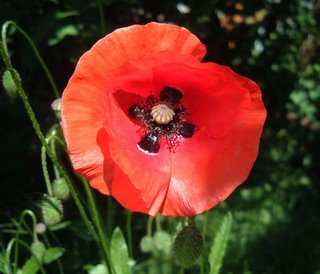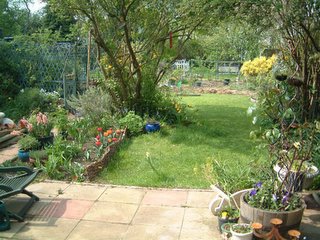
In 1996 I spent a week trawling round the battlefields of the Somme in northern France. I was writing a play about the First World War, and was doing a lot of thinking about those times and what people went through. One of the places I visited was a memorial to the Ulster Division, who had a terrible time at the Battle of the Somme. The British Army were imperialist bastards in those days and considered provincial and colonial soldiers to be more expendable than full-blooded Englishmen, so they were given all the worst jobs. (Maybe things haven't changed that much ... ever noticed how many soldiers killed in Iraq are from Scottish regiments?) Northern Ireland was not really considered a part of Britain at that time so its regiments were sent into battle on the bloodiest parts of the line. The Ulster Division were given the impossible task of attacking and capturing a major German fortification, and were fully expected to fail. But remarkably they did capture it ... mainly by just running straight at it and frightening the Germans off. But having pushed so far forward over the German line they were exposed on three sides and needed back-up troops to follow up and consolidate their position. Unhappily for them, there were no back-up troops. The British command had expected them all to be massacred and hadn't bothered to lay on reinforcements. So the Ulster Division waited, and held their ground and waited, until the Germans came back and recaptured the land and killed them all.
The site where all this happened is a weird place. All picturesque farmland now. An Irish-style tower has been built there as a memorial, and many of the trenches have been left untouched since the Ulster Division occupied them. And there are plenty of reminders. While I was driving up the road to the tower I saw something slip down the steep grass verge into the road in front of me. It was an unexploded Mills bomb.
As it was June when I visited, some of the trenches were filled with poppies, and I collected some seeds.
Just a few months later I got a chance to go over to Northern Ireland, so I took the Ulster poppy seeds with me and sowed them on a grass verge in Co. Armagh, near Lough Neagh, which seemed about as close as I could get to the heart of Ulster.
Then there were the Wilfred Owen poppies.
The Sentry
We'd found an old Boche dug-out, and he knew,
And gave us hell, for shell on frantic shell
Hammered on top, but never quite burst through.
Rain, guttering down in waterfalls of slime,
Kept slush waist-high and rising hour by hour,
And choked the steps too thick with clay to climb.
What murk of air remained stank old, and sour
With fumes of whizz-bangs, and the smell of men
Who'd lived there years, and left their curse in the den,
If not their corpses...
There we herded from the blast
Of whizz-bangs, but one found our door at last,
Buffeting eyes and breath, snuffing the candles,
And thud! flump! thud! down the steep steps came thumping
And sploshing in the flood, deluging muck -
The sentry's body; then his rifle, handles
Of old Boche bombs, and mud in ruck on ruck.
We dredged him up, for killed, until he whined
'O sir, my eyes - I'm blind, - I'm blind, I'm blind!'
Coaxing, I held a flame against his lids
And said if he could see the least blurred light
He was not blind; in time he'd get all right.
'I can't' he sobbed. Eyeballs, huge-bulged like squids',
Watch my dreams still; but I forgot him there
In posting Next for duty, and sending a scout
To beg a stretcher somewhere, and flound'ring about
To other posts under the shrieking air.
* * *
Those other wretches, how they bled and spewed,
And one who would have drowned himself for good, -
I try not to remember these things now.
Let dread hark back for one word only: how
Half-listening to that sentry's moans and jumps,
And the wild chattering of his broken teeth,
Renewed most horribly whenever crumps
Pummelled the roof and slogged the air beneath, -
Through the dense din, I say, we heard him shout
'I see your lights!' But ours had long died out.
Wilfred Owen 1918
On the same trip I decided to try to locate the site of the dug-out occupied by Owen when he served on the Somme in January 1917, where the incident in The Sentry occurred. I had a book which gave a pretty good indication where it was, based on Owen's description of it in letters to his mum and army records of where he was posted at the time, near the village of Serre. The dug-out has since been excavated and restored, but at the time I visited there was nothing visible except a slight dip in the ground in a cornfield. For the most part, the relics of the First World War are hidden unless you know where to look. In the early 1920s most of the trenches were hastily filled in because people just wanted to forget about it.
 But with the help of a 1917 trench map I found what I thought must be the site of part of the trench occupied by Owen at that time (not the dug-out, which was stuck out in No Man's Land, but the British front line a short distance behind it). Quite a weird feeling to be sauntering about in the sunshine on the same spot where Owen floundered under the shrieking air. I worked out the point at which the site of the trench intersected the modern day road, and when I looked ... there was a cross section of the trench wall faintly but distinctly visible in the bank and ditch at the side of the road, including some upright wooden boards with traces of green paint (probably used to line the front wall of the trench) and chunks of rusty shell casing. And a few live shells, some still with their fuses.
But with the help of a 1917 trench map I found what I thought must be the site of part of the trench occupied by Owen at that time (not the dug-out, which was stuck out in No Man's Land, but the British front line a short distance behind it). Quite a weird feeling to be sauntering about in the sunshine on the same spot where Owen floundered under the shrieking air. I worked out the point at which the site of the trench intersected the modern day road, and when I looked ... there was a cross section of the trench wall faintly but distinctly visible in the bank and ditch at the side of the road, including some upright wooden boards with traces of green paint (probably used to line the front wall of the trench) and chunks of rusty shell casing. And a few live shells, some still with their fuses.Also in the trench were the most beautiful wild poppies (Papaver rhoeas) I've ever seen.
They were an incredibly intense deep red with a strong black spot at the base of each petal forming a cross shape, sometimes with a flash of white, and they were bigger and taller than usual. I've never seen anything like them growing wild in England, although botanically they're the same species we get over here. There weren't any ripe seedheads, so I had to collect some unripe ones and hope for the best.
When I did sow them they came up lovely. The flowers aren't quite as spectacular as the ones I originally saw (they miss the French soil and climate) but I love them and have been growing them ever since. Most wild flowers grow best in poor soil, but the Somme poppies like to grow in rich soil and be nurtured. If they're not fed sufficiently they revert to a smaller flower form with no basal blotch.
That's what I find so interesting about poppies, and no doubt the reason they've survived so robustly in the wild: they are incredibly adaptable. If a plant finds itself growing in less than ideal conditions it simply produces smaller and less exciting flowers ... and can adjust itself continually over the course of a single season. Poppies are cornfield weeds and have adapted to patterns of agriculture, germinating as soon as the ground has been ploughed so that they get a headstart on the corn. The seeds are sensitive to soil disturbance, and can lie dormant for 100 years until conditions are right. This is of course the real reason the First World War battlefields were so spectacularly colonised by poppies when hostilities ended: four years of pounding the earth with high explosives stimulated a mass-germination of dormant seeds.
 The direct offspring of the poppies from Owen's trench growing in my garden
The direct offspring of the poppies from Owen's trench growing in my garden



